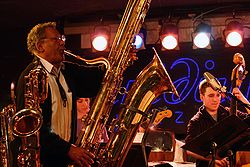- Contrabass saxophone
-
Contrabass Saxophone 
Anthony Braxton performing on
a contrabass saxophone.Classification Aerophone Hornbostel–Sachs classification 422.212-71
(Single-reeded aerophone with keys)Inventor(s) Adolphe Sax Developed 28th June 1846[1] Playing range
In E♭: sounds two octaves and a major sixth lower than writtenRelated instruments Military band family:
- Sopranino saxophone
- Soprano saxophone
- Alto saxophone
- Tenor saxophone
- Baritone saxophone
- Bass saxophone
- Contrabass saxophone
- Subcontrabass saxophone
Orchestral family:
Other saxophones:
- Sopranissimo saxophone ('Soprillo')
- Tubax
Musicians More articles The contrabass saxophone is the lowest-pitched extant member of the saxophone family proper. It is extremely large (twice the length of tubing of the baritone saxophone, with a bore twice as wide, standing 1.9 meters tall, or 6 feet four inches) and heavy (approximately 20 kilograms, or 45 pounds), and is pitched in the key of E♭, one octave below the baritone.
Contents
History
The contrabass saxophone was part of the original saxophone family as conceived by Adolphe Sax, and is included in his saxophone patent of 1846, as well as in Kastner's concurrently published Methode for saxophone. By 1849, Sax was displaying contrabass through sopranino saxophones at exhibitions. The contrabass' first known orchestral use was in Jules Massenet's operas La Vierge of 1879 and Hérodiade of 1881. Patrick Gilmore's famous American band roster included a contrabass saxophone in 1892, and at least a dozen of these instruments were built by the Evette-Schaeffer company for the US military bands in the early 20th century. Saxophone ensembles were also popular at this time, and the contrabass saxophone was an eye-catching novelty for the groups that were able to obtain one. By the onset of the Great Depression, the saxophone craze had ended, and the contrabass, already rare, all but disappeared from public view.
Modern instruments
In recent years, however, the contrabass saxophone has experienced a resurgence in interest. Although still quite rare, perhaps partly due to its great expense, three manufacturers now produce contrabass saxophones: Benedikt Eppelsheim of Munich, Germany[2] Romeo Orsi Wind Instruments of Milan, and J’Elle Stainer of São Paulo, Brazil.
Use
Due to its large body and wide bore, the sound of the contrabass saxophone has great acoustical presence and a very rich tone. It can be smooth and mellow, or harsh and buzzy depending on the player, and on the mouthpiece and reed combination used. Its middle and upper registers are warm, full, and expressive. Because its deepest tones vibrate so slowly (as with the contrabassoon or pedal notes on a pipe organ) it can be difficult for listeners to perceive individual pitches at the bottom of its range; instead of hearing a clearly delineated melody, listeners may instead hear a series of rattling tones with little pitch definition. However, when these tones are reinforced by another instrument playing at the octave or fifteenth, they sound clearly defined and have tremendous resonance and presence. In some contemporary jazz/classical ensembles the contrabass saxophone doubles the baritone saxophone either at the same pitch or an octave below, depending on the register of the music.
In classical music
While there are few orchestral works that call specifically for the contrabass saxophone, the growing number of contrabass saxophonists has led to the creation of an increasing body of solo and chamber music literature. It is particularly effective as a foundation for large ensembles of saxophones. As an example, the eminent saxophonist Sigurd Raschèr (1907-2001) played the instrument in his Raschèr Saxophone Ensemble, and it is featured on most of the albums by the Nuclear Whales Saxophone Orchestra. Several modern works for orchestra and chamber ensembles were scored for contrabass saxophone by composer Adam Gilberti.
Performers
The contrabass saxophone has most frequently been used as a solo instrument by woodwind players in the genres of jazz and improvised music who are searching for an extreme or otherworldly tone. The difficulty of holding and controlling the instrument (let alone playing it) makes performing on the instrument a somewhat theatrical experience in and of itself. On older instruments, playing is difficult too; it takes an enormous amount of air to sound notes in the low register. Thanks to refinements in their acoustical designs and keywork, modern contrabass saxophones are no more difficult to play than most other saxophones.
An increasing number of performers and recording artists are making use of the instrument, including Anthony Braxton, Paul Cohen, David Brutti, Jay C. Easton, Randy Emerick, Blaise Garza, Marcel W. Helland, Robert J. Verdi, Joseph Donald Baker, Thomas K. J. Mejer, Scott Robinson, Klaas Hekman, Daniel Gordon, Daniel Kientzy, and Todd A. White. It is also used by saxophone ensembles including the Raschèr Saxophone Orchestra Lörrach [1], Saxophone Sinfonia, National Saxophone Choir of Great Britain, Northstar Saxophone Quartet, Koelner Saxophone Mafia, and the Nuclear Whales Saxophone Orchestra [2].
References
- ^ "June 28, 1846: Parisian Inventor Patents Saxophone". Wired.com. http://www.wired.com/thisdayintech/2010/06/0628saxophone-patent. Retrieved 14 February 2011.
- ^ Contrabass saxophone page on the web site of Benedikt Eppelsheim Wind Instrument Company
External links
- J’Elle Stainer
- Contrabass saxophone page from www.contrabass.com website
- Contrabass saxophone page from Jay C. Easton's web site
- http://www.youtube.com/watch?v=nwTorKNmED4
- "Bahamut" by Hazmat Modine (click "Bahamut" to listen)
- MP3 excerpt of "Polpis Dreaming" by Carson P. Cooman, op. 410 (2002) for contrabass saxophone and piano, performed by Jay C. Easton
- Video of Marcel W. Helland playing a Contrabass Saxophone.
Types of Saxophones †Soprillo saxophone • Sopranino saxophone • C Soprano saxophone • Soprano saxophone • Mezzo-soprano saxophone • Alto saxophone • C melody saxophone • Tenor saxophone • Baritone saxophone • Bass saxophone • Contrabass saxophone • ‡Subcontrabass saxophone† not designed by Adolphe Sax• ‡ proposed by Adolphe Sax Categories:- Saxophones
- Contrabass instruments
- E-flat instruments
Wikimedia Foundation. 2010.

